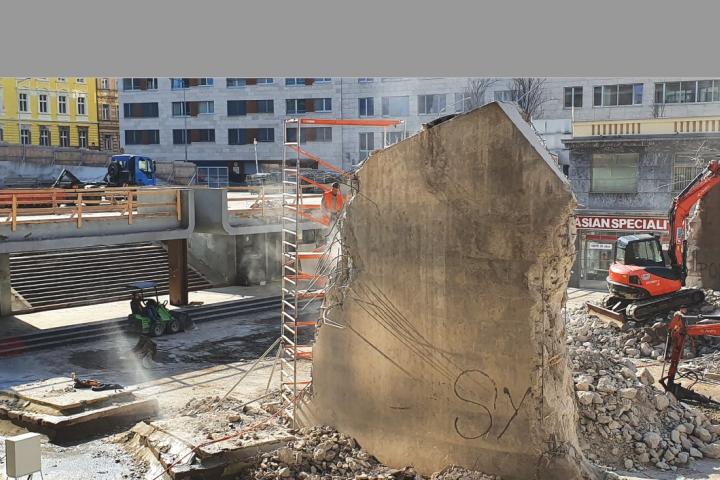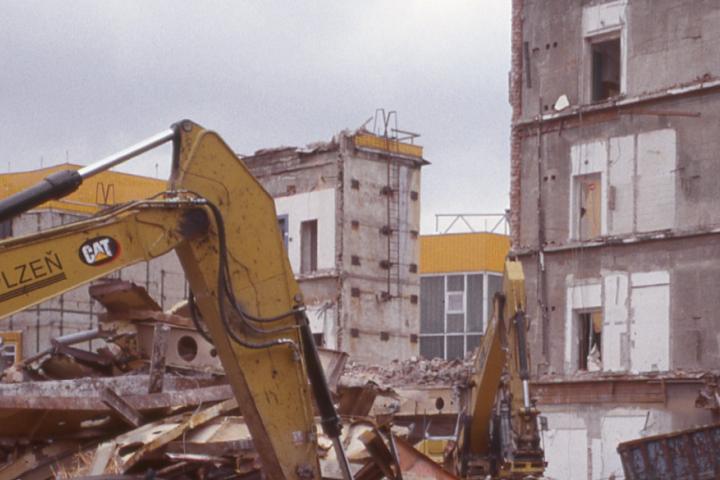
The no longer existing Ještěd department store in Liberec, Transgas buildings or the fuel oil heating plant of the Invalidovna housing estate are mentioned among other buildings. For example, Transgas (the control center for international gas transmission standing next to the Czech Radio building in Prague's Vinohrady) was demolished despite unquestionable architectural and structural qualities and despite strong opposition from the general public, including foreign experts. However, petitions and loud protests and demonstrations did not prevent the demolition of this vigorous and structurally innovative structure, reflecting the techno-optimism period in its distinctive morphology.
This is the first publication of its kind, which deals with the defunct buildings of post-war architecture across all regions. Of course, this is not a complete overview of the defunct or endangered architectural heritage of the post-war era. The buildings were nominated for the book by a combination of an offer of suitable assignments selected by academic staff and doctoral students from the Faculty of Architecture and the personal interest of the students of the seminar Postwar Architecture. The chosen method added a surprising variety to the content of the book and also offers a number of hitherto overlooked buildings, which are, however, interesting for the upcoming generation of architects. There are also general texts and lists of demolished, degraded and endangered buildings, as well as registered or so far only proposed cultural monuments.
"Our intention is not sentiment or a prickly commentary on the state of society and its inability to take care of the heritage of the past responsibly and with a long-term perspective. Rather, we would rather support our common ability to accept and use the diversity of historical architecture in this way. We also want to appeal urgently with a focused presentation of losses. The extinction of a stable natural and built environment, established social and economic security, taking place in our tense present, shows that the values we walk around every day we often begin to appreciate only when we lack them and there is no going back. Therefore, let us move through the already irreversible losses and take the book especially as a memento and lessons for the future, as a call to save and care for the values that still exist and are critically endangered, "writes the book's editor prof. Petr Vorlík. He considers the most important to be the constant attention to architectural qualities and the often unexpected generosity of these buildings as well as the wide possibilities of their further use. Just as previously rejected historicalism, Art Nouveau, functionalism and the architecture of socialist realism were appreciated over time, there is a slow turnaround in the case of architecture from the period of normalization.
The usual argument for the removal of buildings that arose during the years of normalization is their persistent association with propagandistic pride in the achievements of the socialist economy. They represent a product of the time in which the "dull panel housing estates" arose and in which the quality of construction and society "fell to the bottom". Therefore, even thirty years after the Velvet Revolution, a large part of the public seeks to erase these mistakes of the past and demands speedy replacement with something more contemporary. However, high-quality architectural works are often destroyed alongside with the dull and lowly. And the real reasons for demolition usually remain unspoken - especially the pragmatic commercial exploitation of the city. "If we were to demolish everything built under socialism, does that mean we will infill the Prague metro with rubble? Will we remove the crucial motorway from Prague to Brno? Will we demolish most hospitals, schools, cultural and sports buildings? Of course not. It is therefore necessary to look for alternatives. The world is not disposable. The energy invested in architecture should last longer than the narrowly limited interest of the present world, driven by current trends ” explains prof. Petr Vorlík.
The book can be purchased at the University Bookstore of Professional Literature at the National Technical Library, Technická 6, Prague 6 or in its e-shop
Architektura na červeném seznamu / normální je nebourat
Editors: Petr Vorlík, Tereza Poláčková
Published by Česká technika – nakladatelství ČVUT, December 2020
288 pages
ISBN 978-80-01-06759-8
The book was issued with support from FA ČVUT fund as the outup of the project Poválečná architektura – kriticky ohrožený druh (IP RPMT 2019 and IP RPMT 2020) and project Architektura osmdesátých let v České republice – Osobitost, identita a paralelní úvahy na pozadí normalizace (NAKI II).


